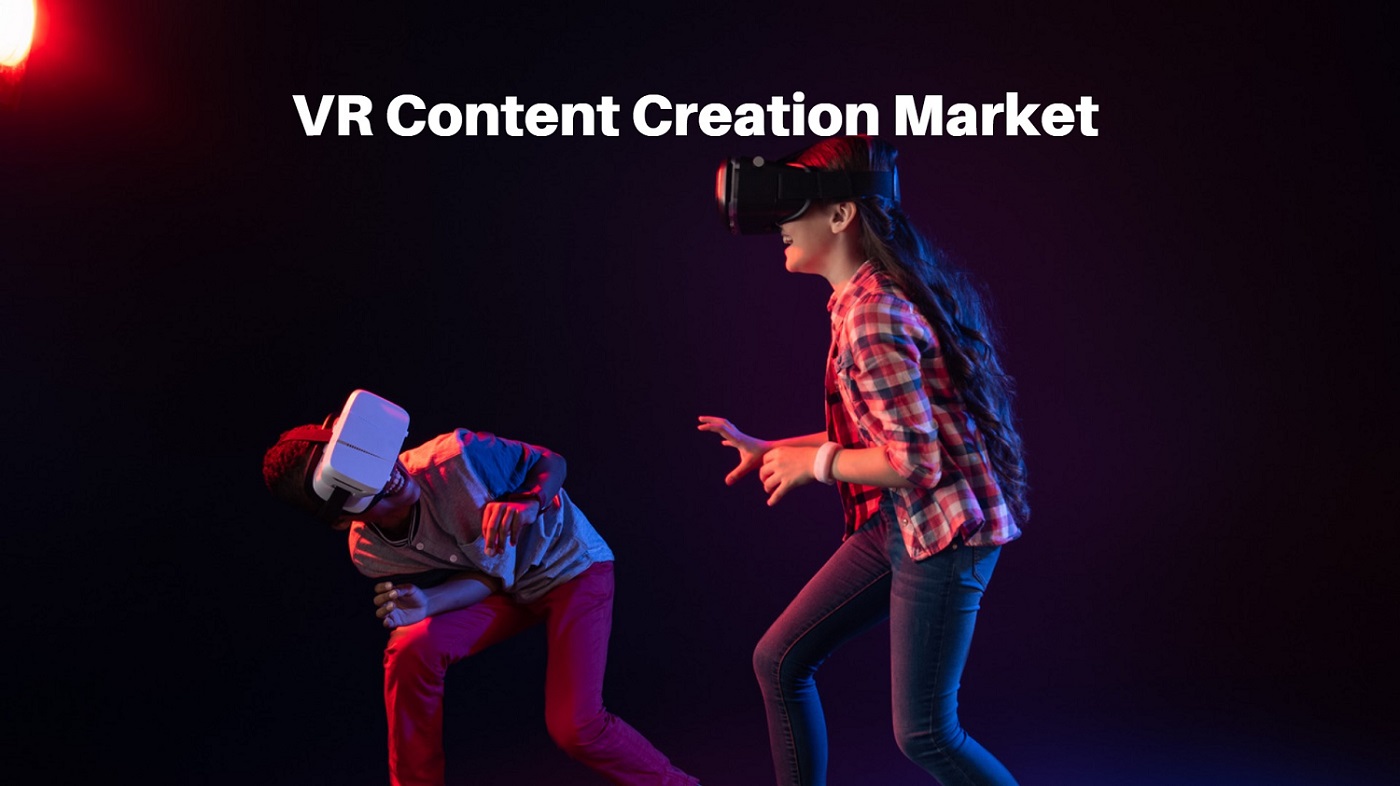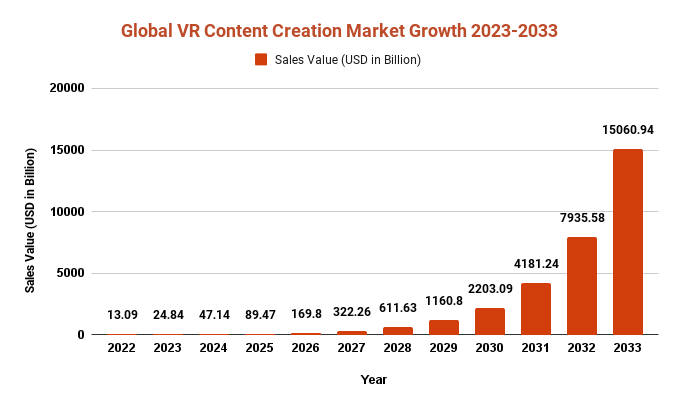VR Content Creation Market Size Expected To Reach USD 15060.94 Bn By 2033 | CAGR: 89.79%

Page Contents
Market Overview
Published Via 11Press: Virtual reality (VR) is an immersive technology that enables users to immerse themselves in a computer-generated environment as if they were actually there. VR content creation Market involves creating, designing, and producing interactive digital experiences for VR devices.
The VR Content Creation Market size is expected to reach USD 15060.94 Bn by 2033, up from its current value of USD 13.09 Bn in 2022, growing at an annual compound growth rate (CAGR) of 89.79% from 2023-2033.
Key Components Involved
- Idea Generation: The initial step in creating VR content is coming up with an idea. This could be a game, simulation, training program or any other type of experience enhanced by VR technology.
- Planning: Once you have an idea, it is time to craft the specifics of the experience. This includes selecting a storyline, selecting an environment, selecting characters and any other elements that will be included.
- Design: Now that the strategy is in place, designers can begin creating the VR experience. This includes creating 3D models of both the environment and characters as well as crafting the user interface.
- Development: Once the design is approved, development can begin. This involves writing code to bring the VR experience to life. Developers must optimize this experience for whatever VR platform they are targeting.
- Testing: Once development is complete, the VR experience must be rigorously tested to guarantee it functions correctly and is enjoyable for users. This includes looking for bugs or glitches as well as gathering feedback from users.
- Deployment: Once the VR experience has been tested and refined, it can be made available to users through platforms such as Oculus Store or SteamVR.
Producing VR content necessitates a combination of creativity, technical proficiency and meticulous attention to detail. With the right approach however, it is possible to craft immersive and captivating VR experiences that will captivate users and offer them new ways to engage with digital content.
Key Takeaways
- VR content creation involves the process of developing, designing, and producing interactive digital experiences for VR devices.
- The process includes idea generation, planning, design, development, testing, and deployment.
- VR content creators need to have a combination of creativity, technical skill, and attention to detail.
- VR content can be used for various purposes, including gaming, education, training, and entertainment.
- VR content needs to be optimized for the specific VR platform it is targeting, as well as tested thoroughly to ensure it works properly and is enjoyable to use.
- VR content creation is a rapidly growing field, with many opportunities for those with the right skills and expertise.

Request For Sample Report Here: https://marketresearch.biz/report/vr-content-creation-market/request-sample/
Regional Snapshot
- North America:
North America is the leading region in VR content creation. It boasts an established tech industry, including major players like Oculus, HTC and Unity. Furthermore, with many skilled professionals, access to funding and an established VR market, North America has become a prime location for VR creators. - Europe:
Europe is an excellent region for VR content production. It boasts a growing VR market and vibrant tech industry. Countries such as the UK, Germany, and France boast high concentrations of VR companies and skilled professionals. - Asia Pacific:
The Asia-Pacific region is rapidly becoming a hub for VR content production. China in particular boasts an expansive and rapidly developing VR market, with numerous companies investing heavily in this space. Japan and South Korea also boast robust tech industries with numerous VR companies located there. - Latin America:
While Latin America is a smaller market for VR content creation than its American counterparts, it has seen growth in recent years. Countries such as Brazil and Mexico have an emerging tech industry with numerous startups and skilled professionals. - Middle East and Africa:
The Middle East and Africa are rapidly becoming hubs for VR content production. There is a small but growing number of VR companies in these regions, while governments are investing in tech infrastructure to foster growth within the industry. Nonetheless, these markets remain at their early stages of development.
Inquire Here & Query for report: https://marketresearch.biz/report/vr-content-creation-market/#inquiry
Drivers
- VR technology enables users to enter a virtual world and interact with it in ways previously impossible. This has spurred an explosion of demand for VR content, especially within gaming, education and entertainment industries. Thanks to advances in hardware and software design, creating high-quality VR productions is now easier thanks to improved graphics, faster processing speeds and user-friendly development tools. In recent years the market for VR content creators has grown steadily as more people purchase headsets to explore this immersive medium. Now there are more opportunities than ever for creators of such works to reach wider audiences!
- Venture capitalists and other investors have invested heavily in VR technology, providing funding for startups to develop new and creative VR content. VR has enormous potential in training and education – particularly within industries such as healthcare or aviation – creating a demand for VR content that can serve these purposes.
Restraints
- Generating high-quality VR content requires significant investments in hardware, software and talent. This can be a deterrent for smaller companies or independent developers as the cost of entry into this field may be quite high. Though the VR market is growing, it still remains small compared to other industries such as gaming or film. This means that while there may be a limited audience for VR content creators, it can still prove challenging for them to generate significant revenue from sales. Producing VR content can be a complex technical feat, requiring an in-depth knowledge of both software development and 3D design. Creators may experience difficulties such as optimizing their work for different VR platforms, producing realistic animations, or reducing motion sickness.
- Contrary to other industries such as mobile app development or web development, there is currently no standardized set of tools or platforms for VR content creation. This makes it challenging for developers to create content that works across multiple VR devices. In certain sectors such as healthcare or education, regulatory hurdles may exist that must be cleared in order to create and distribute VR content – such as patient privacy issues or data security concerns.
Opportunities
- VR technology holds great promise for creating immersive gaming experiences. As the gaming industry continues to develop and grow, there are numerous opportunities for VR content creators to create new and innovative games that take advantage of this advanced technology. VR technology holds the potential to revolutionize education and training by providing users with a safe, controlled environment in which to simulate real-world scenarios and engage with them. VR content creators have the potential to create educational and training content for various industries, such as healthcare, aviation, and manufacturing. VR technology can also be utilized to create immersive marketing and advertising experiences that engage customers in new and creative ways – from product demos to virtual store tours.
- VR technology can be employed to create virtual travel experiences that offer users the chance to explore various destinations from around the world. This has enormous potential in tourism and travel industries, as it gives potential visitors a chance to experience a destination before they commit to booking a trip. Furthermore, VR can create social and collaborative experiences which enable users to interact with each other virtually; this has applications in remote work settings or online communities where individuals can connect and work together virtually.
Challenges
- One of the biggest challenges in VR content creation is the limitations of the hardware. While hardware is becoming more advanced, it still lags behind the needs of high-quality VR content creation, which can limit the quality and scope of VR experiences that can be created. VR content creation can be very expensive, with the need for specialized equipment and personnel to create high-quality experiences. This can be a barrier for smaller companies or independent developers, as the cost of entry into the industry can be high.
- Creating VR content is technically challenging and requires a deep understanding of both software development and 3D design. Developers must consider issues such as optimizing content for different VR platforms, creating realistic animations, and reducing motion sickness. VR content creators must develop user interfaces that are intuitive and easy to use. However, there are few established best practices for UI design in VR, which can make it difficult to create effective interfaces that work seamlessly across different devices. Distributing VR content can be challenging, as there are currently few established channels for content distribution. This can limit the reach of VR content and make it difficult for VR content creators to monetize their work.
Market Segmentation
By Content Type
- Videos
- 360 Degree
- Immersive
- 360 Degree Photos
- Games
By Solution
- Software/Application
- Services
By End-Use Sector
- Real Estate
- Travel, Hospitality and Events
- Media and Entertainment
- Retail
- Gaming
- Automotive
- Others
Key Players
- Koncept VR
- VOXELUS.
- SubVRsive
- Panedia Pty Ltd.
- WEMAKEVR
- 360 Labs
- MATTERVR and Elysian Studio Private Limited (Meraki)
- Matterport
- Wevr
- Vizor
- Blippar
Report Scope
| Report Attribute | Details |
| Market size value in 2022 | USD 13.09 Bn |
| Revenue forecast by 2033 | USD 15060.94 Bn |
| Growth Rate | CAGR Of 89.79% |
| Regions Covered | North America, Europe, Asia Pacific, Latin America, and Middle East & Africa, and Rest of the World |
| Historical Years | 2017-2022 |
| Base Year | 2022 |
| Estimated Year | 2023 |
| Short-Term Projection Year | 2028 |
| Long-Term Projected Year | 2033 |
Growing Demand => Request for Customization
Recent Developments
- Social VR: These platforms enable users to explore virtual worlds and are rapidly gaining traction. This technology could revolutionize how people communicate and collaborate online.
- VR Streaming: YouTube, Twitch and Vimeo now enable VR content streaming. This makes it simpler for creators and publishers to reach a wider audience, monetize their work more efficiently, and make more money.
- VR Tools: Developers now have access to a suite of VR-specific tools, such as game engines and 3D modeling software. This makes creating high-quality VR content much simpler.
- VR Headsets: Accessing virtual reality has never been simpler thanks to standalone headsets like Oculus Quest. This has led to an uptick in demand for VR content and created new opportunities for creators.
- Virtual Reality in Education: Educational institutions have begun utilizing virtual reality technology to enhance learning experiences. This could include immersive training simulations or simulated field trips.
Key Questions
1. What platform will the content be created for?
– There are various VR platforms, each with its own advantages and drawbacks. Understanding which one your content should be created on is key in crafting content that works well and appeals to its intended audience.
2. What is the target audience for your content?
– Different audiences will have distinct needs and expectations when it comes to VR content. Knowing who your intended audience is is essential in crafting engaging and pertinent material.
3. What is the purpose of the content?
– VR content can be created for many purposes, from entertainment to education and marketing. Determining why you create something is critical in crafting material that satisfies its intended objectives.
4. What is the budget for this project?
– VR content creation can be costly, so it's essential to have an accurate estimate before beginning work on a venture. Doing this helps guarantee resources are allocated efficiently and the endeavor stays on track.
5. How will the content be distributed?
– Distributing VR content can be a complex task, so having an organized plan for distribution before beginning any project is essential. This includes selecting appropriate distribution channels and optimizing the material for different platforms.
6. How will user feedback be included in the development process?
– VR content creation is an iterative endeavor, so taking into account user input is essential for creating engaging and effective materials. Having a systematic plan for collecting and using feedback helps guarantee that the final product meets the expectations of its intended audience.
Contact us
Contact Person: Mr. Lawrence John
Marketresearch.Biz (Powered By Prudour Pvt. Ltd.)
Tel: +1 (347) 796-4335
Send Email: [email protected]
The team behind market.us, marketresearch.biz, market.biz and more. Our purpose is to keep our customers ahead of the game with regard to the markets. They may fluctuate up or down, but we will help you to stay ahead of the curve in these market fluctuations. Our consistent growth and ability to deliver in-depth analyses and market insight has engaged genuine market players. They have faith in us to offer the data and information they require to make balanced and decisive marketing decisions.



